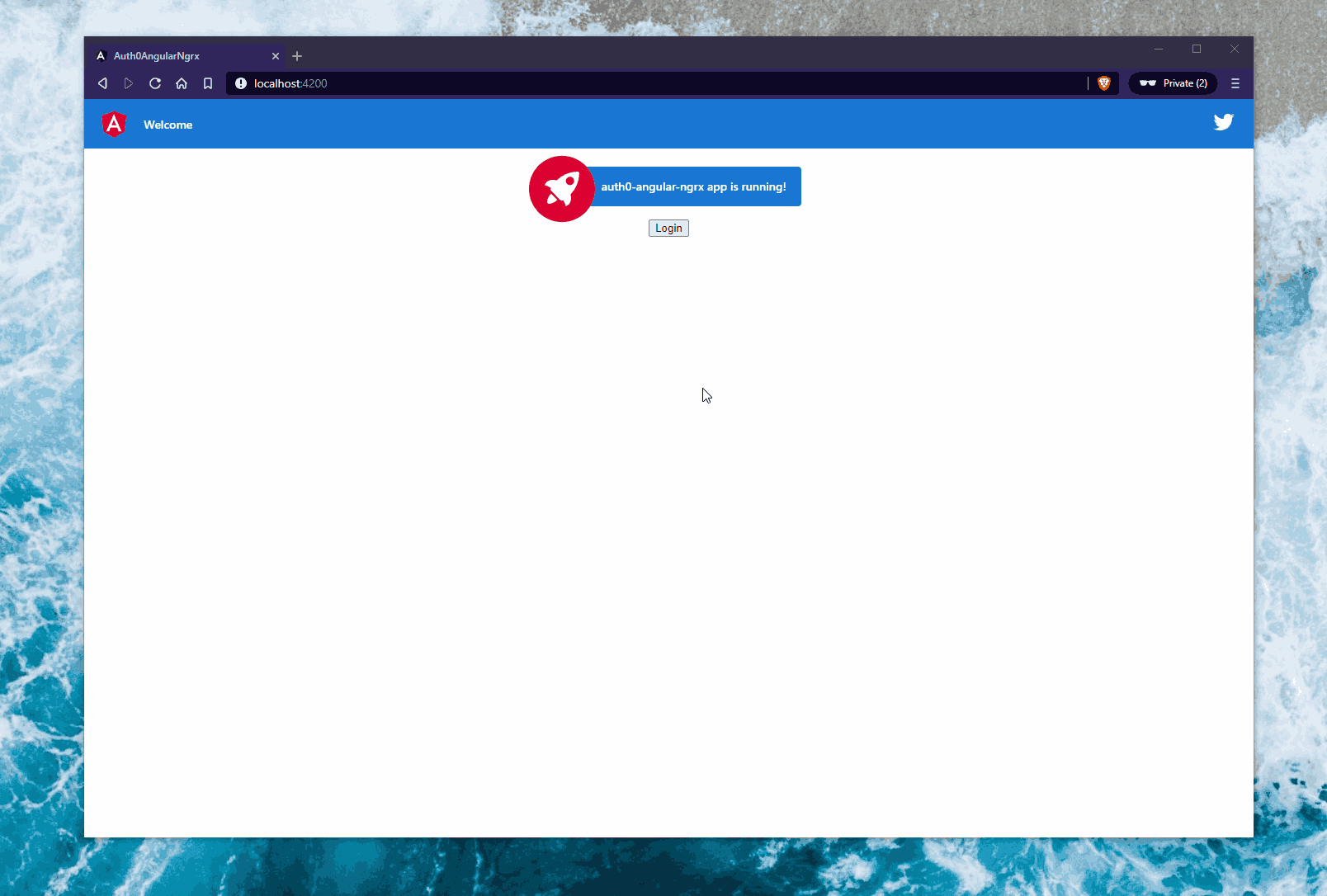Using Auth0 in Angular With NgRx
In this blog post I want to show how we can add Auth0 authentication into an Angular app when using state management with NgRx.
We are going to look how you can place authentication with Auth0 in an Angular app to provide a login and a logout and going a little beyond the incredibly good tutorial The Complete Guide to Angular User Authentication with Auth0. Also, there is already a blog post I am happy to link to: NgRx Authentication Tutorial. In this blog we are starting from the beginning and refer to the next syntax in NgRx and maybe an alternative way. I recommend giving the resources a read, they really helped me a lot.
However, let us start.

Code can be found here https://github.com/FabianGosebrink/auth0-angular-ngrx/
Adding the App in Auth0
Before we start, we should add our new Angular app in the portal of Auth0.
First create an account and add your application in the dashboard of Auth0. Be sure to select Single page Web Application as we are doing an Angular app next.

Once this is created, and we know that our Angular app will run on the domain http(s)://localhost:4200 locally, be sure to add these URLs into the correct fields of Auth0. I am adding both, HTTP and HTTPS, here. In case that I switch to HTTPS, I do not have to get that entries changed again.

On the same page where we add the allowed URLs on top, there is a chapter for the Basic Information. We need the values ClientId and Domain from there and place it in our Angular application next.
Creating the Angular app and install the dependencies
We can create the Angular app with
ng new auth0-angular-ngrx
After creating let us install the Angular helpers from Auth0 @auth0/auth0-angular.
npm install @auth0/auth0-angular
Adding the Auth service abstraction
As Auth0 is a third party lib here, I like to create an abstraction for this. Auth0 provides us an incredibly good API where to write a wrapper for is no big effort.
So we can add a file called auth.service.ts and place it in root (or where ever you want to, for the sake of simplicity we get it into root now).
.
├── src
│ ├── app
│ │ ├── ...
│ │ ├── app.module.ts
│ │ └── auth.service.ts // <<< ADD THIS!
│ ├── ...
├── ...
import { Injectable } from '@angular/core';
import { AuthService } from '@auth0/auth0-angular';
import { Observable } from 'rxjs';
@Injectable({
providedIn: 'root',
})
export class AuthenticationService {
constructor(public authService: AuthService) {}
get isLoggedIn$(): Observable<boolean> {
return this.authService.isAuthenticated$;
}
getToken$(): Observable<string> {
return this.authService.getAccessTokenSilently();
}
get user$(): Observable<any> {
return this.authService.user$;
}
login(): void {
this.authService.loginWithRedirect();
}
logout(): void {
this.authService.logout({ returnTo: document.location.origin });
}
}
In the effects later, we will use the AuthenticationService to communicate with Auth0.
Including AuthModule
We must include the AuthModule from @auth0/auth0-angular and pass in the information we have, like our clientId and our domain. You can find both of it in your dashboard on Auth0 in the Basic Information area right on top of the app.
import { NgModule } from '@angular/core';
import { AuthModule } from '@auth0/auth0-angular';
import { AppComponent } from './app.component';
@NgModule({
declarations: [AppComponent],
imports: [
AuthModule.forRoot({
domain: '<your domain>',
clientId: '<your client id>',
redirectUri: window.location.origin,
}),
],
bootstrap: [AppComponent],
})
export class AppModule {}
Adding NgRx
To add NgRx we must add the dependencies @ngrx/store and @ngrx/effects first.
ng add @ngrx/store@latest
ng add @ngrx/effects@latest
After having done this we can create a folder in the root called store where we place all the NgRx related files in.
.
├── e2e
│ ├── ...
├── src
│ ├── app
│ │ ├── store // <<< ADD THIS!
│ │ │ └── ...
│ │ ├── ...
│ ├── ...
├── ...
...
Adding the Actions
For the actions we will create a file called auth.actions.ts and add the first action to trigger the login called login, a corresponding action for completeness called loginComplete, same for logout and logoutComplete. When Auth0 redirects back to our application we need a trigger to tell the state that is must be changed, where an action checkAuth is introduced for.
import { createAction, props } from '@ngrx/store';
export const checkAuth = createAction('[Auth] checkAuth');
export const login = createAction('[Auth] login');
export const loginComplete = createAction(
'[Auth] loginComplete',
props<{ profile: any; isLoggedIn: boolean }>()
);
export const logout = createAction('[Auth] logout');
export const logoutComplete = createAction('[Auth] logoutComplete');
.
├── src
│ ├── app
│ │ ├── store
│ │ └── auth.actions.ts
│ └── ...
├── ...
Adding the reducer and the state
The state of our application will be an object with a property called auth and the values userProfile and isLoggedIn.
{
auth: {
isLoggedIn,
userProfile
}
}
To build that into code we can define an interface in the reducer file we have to create auth.reducer.ts in the store folder and add our state as an interface.
.
├── src
│ ├── app
│ │ ├── store
│ │ │ ├── auth.actions.ts
│ │ │ ├── auth.reducer.ts
│ └── ...
├── ...
import { Action, createReducer, on } from '@ngrx/store';
export interface AuthState {
userProfile: any;
isLoggedIn: boolean;
}
export const initialState: AuthState = {
userProfile: null,
isLoggedIn: false,
};
const authReducerInternal = createReducer(
initialState
/* */
);
export function authReducer(
state: AuthState | undefined,
action: Action
): AuthState {
return authReducerInternal(state, action);
}
The AuthState is the representation of the value the auth property has in our state. This reducer only takes care about anything that goes on inside of the auth property.
We are setting the initialState and create the reducer getting passed the initialState. What we must do is adding the state manipulation when a specific action comes in.
If the login is completed with the action loginComplete we want to add the profile we received and the isLoggedIn is set, too. When the action logoutComplete is being thrown, we reset userProfile to null and isLoggedIn to false.
import { Action, createReducer, on } from '@ngrx/store';
import * as authActions from './auth.actions';
// all states and interfaces
const authReducerInternal = createReducer(
initialState,
on(authActions.loginComplete, (state, { profile, isLoggedIn }) => {
return {
...state,
userProfile: profile,
isLoggedIn,
};
}),
on(authActions.logoutComplete, (state, {}) => {
return {
...state,
userProfile: null,
isLoggedIn: false,
};
})
);
// export functions
Adding the effects
We are using effects for the asynchronous work to do when we are trying to manipulate the state after async actions like an http request have finished.
There are three actions to listen to: the login, the logout and the checkAuth action which updates the state after redirecting.
.
├── src
│ ├── app
│ │ ├── store
│ │ │ ├── auth.actions.ts
│ │ │ ├── auth.effects.ts
│ │ │ ├── auth.reducer.ts
│ └── ...
├── ...
@Injectable()
export class AuthEffects {
constructor(
private actions$: Actions,
private authService: AuthenticationService
) {}
// effects go here
}
The login effect will only call the authService.login() action and won’t dispatch any other action then.
login$ = createEffect(
() =>
this.actions$.pipe(
ofType(fromAuthActions.login),
tap(() => this.authService.login())
),
{ dispatch: false }
);
We will throw the checkAuth action when we are getting redirected from Auth0 to our app again. The service from Auth0 got updated then with the latest information which we must collect and add to our state: isLoggedIn$ and user$ are the properties we want to collect and update the state with. If isLoggedIn resolves to true – which should be the case after the redirect – we can return a loginComplete action. Otherwise, we reset the state with a logoutComplete action.
login$ = createEffect(/* ... */);
checkAuth$ = createEffect(() =>
this.actions$.pipe(
// If an action with the type 'checkAuth' occurs in the actions$ stream...
ofType(fromAuthActions.checkAuth),
// return an observable including the latest info from 'isLoggedIn' and 'userProfile'
switchMap(() =>
combineLatest([this.authService.isLoggedIn$, this.authService.user$])
),
// Take it out and return the appropriate action based on if logged in or not
switchMap(([isLoggedIn, profile]) => {
if (isLoggedIn) {
return of(fromAuthActions.loginComplete({ profile, isLoggedIn }));
}
return of(fromAuthActions.logoutComplete());
})
)
);
The logout action calls the authService.logout() method and returns the logoutComplete again.
logout$ = createEffect(() =>
this.actions$.pipe(
ofType(fromAuthActions.logout),
tap(() => this.authService.logout()),
switchMap(() => of(fromAuthActions.logoutComplete()))
)
);
Providing the state to the module
Until here, we have not told our application module about our state yet. Like said already, we want our state to be.
{
auth: {
isLoggedIn,
userProfile
}
}
Which is exactly what we provide in our StoreModule.forRoot() in the forRoot() method:
import { NgModule } from '@angular/core';
import { EffectsModule } from '@ngrx/effects';
import { StoreModule } from '@ngrx/store';
import { AuthEffects } from './store/auth.effects';
import { authReducer } from './store/auth.reducer';
@NgModule({
imports: [
StoreModule.forRoot({ auth: authReducer }), // State object here like described
EffectsModule.forRoot([AuthEffects]),
],
bootstrap: [AppComponent],
})
export class AppModule {}
In addition to that, we wire up the effects by passing them into the forRoot() method of the EffectsModule from @ngrx/effects.
Adding the selectors
To make the consumption in the component clear, we can build selectors which select exactly what we need from the state and provide it.
.
├── src
│ ├── app
│ │ ├── store
│ │ │ ├── auth.actions.ts
│ │ │ ├── auth.effects.ts
│ │ │ ├── auth.reducer.ts
│ │ │ └── auth.selectors.ts
│ └── ...
├── ...
We need to create a selector for the isloggedIn and for the userProfile property as well as getting the first step: the auth property from the state object we described.
import { createFeatureSelector, createSelector } from '@ngrx/store';
import { AuthState } from './auth.reducer';
// get the `auth` property from the state object
export const getAuthFeatureState = createFeatureSelector<AuthState>('auth');
// get the userProfile from the auth state
export const selectCurrentUserProfile = createSelector(
getAuthFeatureState,
(state: AuthState) => state.userProfile
);
// get the isLoggedIn from the auth state
export const selectIsLoggedIn = createSelector(
getAuthFeatureState,
(state: AuthState) => state.isLoggedIn
);
Building the Component
The component consumes the selectors to consume the values in the state and dispatches the action checkAuth() when it is loaded to update the information in the state
import { select, Store } from '@ngrx/store';
import { checkAuth, login, logout } from './store/auth.actions';
import {
selectCurrentUserProfile,
selectIsLoggedIn,
} from './store/auth.selectors';
@Component({
/* */
})
export class AppComponent implements OnInit {
title = 'auth0-angular-ngrx';
loggedIn$: Observable<boolean>;
profile$: Observable<any>;
constructor(private store: Store<any>) {}
ngOnInit() {
this.loggedIn$ = this.store.pipe(select(selectIsLoggedIn));
this.profile$ = this.store.pipe(select(selectCurrentUserProfile));
this.store.dispatch(checkAuth());
}
logout() {
this.store.dispatch(logout());
}
login() {
this.store.dispatch(login());
}
}
It also provides two methods to login and logout. As we have done all the work before, the component looks very clean.
In the template, we can now use the information as needed
<div>
<div *ngIf="loggedIn$ | async as loggedIn; else loginContent">
<p>
<button (click)="logout()">Logout</button>
is logged in {{ loggedIn }}
</p>
<div *ngIf="profile$ | async as profile">
<img [src]="profile.picture" />
<pre>{{ profile | json }}</pre>
</div>
</div>
<ng-template #loginContent
><button (click)="login()">Login</button></ng-template
>
</div>
And that is it.
The result can be seen on GitHub https://github.com/FabianGosebrink/auth0-angular-ngrx/









